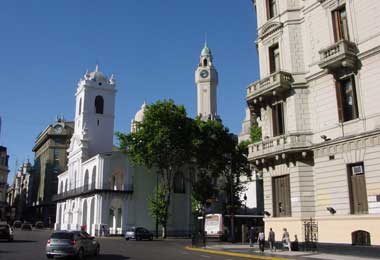The Independent's journalism is supported by our readers. When you purchase through links on our site, we may earn commission.
Off Duty: Buenos Aires
Ian McCurrach gets to grips with the most vibrant city in the Americas

Why?
Hotter than Rio and just as cool as New York, Buenos Aires is currently the most vibrant city in the Americas.
An indication that a city has arrived is when it hosts a raft of hip hotel openings attracting the smart business set. One of the most recent to open its doors is the Palacio Duhau ( www.buenosaires.park.hyatt.com) in Recoleta – a marriage of classic and contemporary, uniting a restored palace designed in 1934 by French architect Leon Sourge, with a new Posadas building, designed by Gabriela Iglesias. This hotel sums up Buenos Aires now; it seamlessly integrates the city’s legendary old time glamour with 21st-century innovative design and state-of-the-art technology.
Buenos Aires today means business. Perhaps one of the most exciting aspects of the city is the entrepreneurial spirit of the portenos (BA locals). The fiscal crisis of the early Noughties inspired creative thinking among the city’s young professionals who have started new commercial enterprise. Similarly, the strong artistic community has been talking, writing, singing and dancing about the new reality.
The city’s wide Haussmann-style tree-lined boulevards, ornate parks and Belle Epoque architecture have more in common with Paris and Madrid than Argentina. What is so intriguing about this hedonistic capital is that it blurs the distinctions between Europe and Latin America; it has taken the best of Spanish, British, French and Italian cultures and made them entirely its own.
What?
Getting to grips with the city can prove daunting. With a population of some 11.5 million spread out across 47 districts, or barrios, it’s impossible to step out from your hotel and follow the usual cultural signposts. Thankfully, BA is short on big box-office draws, so it’s easy to get those swiftly out of the way allowing time to explore the different neighbourhoods.
Not to be missed are Recoleta – all-English Mayfair, fancy stores and cemetery complete with feral cats; La Boca – the biggest Italian community outside Italy and home to the colourful Boca Juniors football team; Palermo Viejo (Hollywood and Soho) – crammed with trendy boutiques, bars and restaurants; San Telmo – the original Spanish settlement, now one of the biggest and best antique centres in the world; Micro Centro, Congreso and Tribunales – all stately buildings including the Pink House or Casa Rosada, where Evita famously waved from the balcony to her people.
The Subte (metro) is worth exploring because it dates from 1912 and still operates with the original wooden cars just underneath the city streets. For nostalgia, take line A, which displays its original 1930s posters.
But one of the coolest ways of seeing the city is on a guided bike tour. Buenos Aires Urban Biking (00 54 11 4568 4321; www.urbanbiking.com) was set up by a group of young students and offers four insiders’ itineraries, each exploring different aspects of the city.
Where?
The city is hard to beat when it comes to restaurants and bars. One of the top tables is Sucre at Sucre 676 (00 54 11 4782 9082; www.sucrerestaurant.com.ar) in Bajo Belgrano. Its vast theatrical, post-industrial chromatic interior was designed by Juan Ballester, one of the hot young porteno architects. Casa Cruz at Uriarte 1658 (00 54 11 4833 1112; www.casa-cruz.com) is another of BA’s hottest tables. The stunning redwood panelled lounge with low lighting has vast distances between the tables and a rear wall that is a giant floor-to-ceiling wine cellar.
Images of 1940s Shanghai are conjured up at Club 647, at Tacuari 647 (00 54 11 4331 3026; www.club647.com) in San Telmo. This restaurant-cum-bar-cum-club has gigantic crystal chandeliers and immense walls covered with French antique mirrors. Gran Vega Cigar Bar, at Cabrera 4667 (00 54 11 4832 2703; www.granvega.com.ar) is one of the city’s newest hotspots in Palermo Soho. The dark masculine contemporary interior evokes the spirit of Cuba and has more of its fair share of after-work cocktail networking.
The portenos love to party so nightlife features highly here. Asia de Cuba, at Pierina Dealessi 750 ( www.asiadecuba.com.ar) and Mint (Avenida Costanera Rafel Obligado; www.puntacarrasco.com.ar) offer high-maintenance disco fever.
Wow
Head down to Puerto Madero for a futuristic vision. The former docklands area has been transformed and is home to jaw-dropping architecture by the likes of Richard Rogers. A fine example is The Faena Hotel + Universe ( www.faenahotelanduniverse.com). The result of the successful coupling of fashion designer Alan Faena and Philippe Starck, the Faena is housed in a former seven-storey grain silo dating from 1902. Far more lavish and comfortable than Starck’s work for Ian Schrager, the design concept fuses imperial opulence with contemporary extravagance.
Join our commenting forum
Join thought-provoking conversations, follow other Independent readers and see their replies
Comments
Bookmark popover
Removed from bookmarks